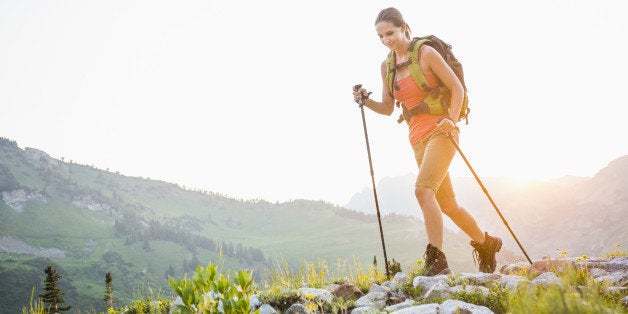
On the trail, I often get asked by newer hikers why I have a pair of "ski poles" in my hands. While trekking poles may look a bit silly at first, I've found that they're incredibly versatile tools that can help with all sorts of small tasks along the trail.
1. Help you keep your stride or pace
When you're out hiking on relatively easy terrain, getting into a rhythm can help the miles fly by. You'll get into a groove where you stride and your breathing start to sync up, which will help you maintain your pace. Adding trekking poles to the mix adds another element to the rhythm and helps you stay focused.
2. Give you a boost on uphills
Your legs have to work extra hard if you're doing lots of uphill hiking. Planting your poles and boosting yourself up with your arms helps take some of the stress off your leg muscles and helps you stay fresher for longer.
3. Take shock off your knees on downhills
Before I got poles, long descents meant that my knees and ankles would get sore from constantly absorbing my weight pounding down on them with every step. With trekking poles, you can catch some of your weight with your arms, so that it's not all transferred to your joints. Poles also aid with stability on steep sections or large drops.
4. Great for balance on slippery rocks or uneven terrain
If you spend any time hiking around rivers or creeks, you probably know the frustration of stepping on a slick rock and feeling your foot slide when you shift your weight. Sometimes you can catch yourself with your other foot or hands, but sometimes you end up falling on your face and banging your knee or hands in the process. Sticking a trekking pole out allows you to stop those slips from turning into face plants, and saves your dignity in the process.
5. Extra points of contact for river crossings
Even shallow, seemingly slow moving water can make river crossing very difficult and treacherous. One bad step and you've fallen in, gotten soaked and may potentially find yourself being whisked downstream. Using poles gives you extra points of contact that can keep your upright in the event that something shifts underfoot.
6. Whacking bushes, branches and spider webs out of the way
Trekking poles can be invaluable for pushing branches and bushes out of the way on crowded trails with lots of overhanging vegetation. You can swing them through spiderwebs so those don't end up plastered across your face. Not sure if that plant growing over the edge of the trail is poison ivy? Whack it out of the way with your pole and avoid having to find out!
7. Testing a sketchy looking rock before you put weight on it
On rocky terrain, you might see a potential step that looks a little sketchy. It's right where you need to put your foot, but you find yourself wondering if you should trust it with your weight. Putting your pole on it and giving it a shove is a great way to test a step before trusting it with your full body weight.
8. Fending off animals like snakes or small rodents
If you've ever hiked in the desert through low brush, then you know the terror of wondering whether each bush is concealing a snake, scorpion or other pest, waiting to strike. With poles, you can whack at potential hiding places before stepping through them with your legs and risking a bite or sting.
9. Supports for pitching a tarp
Even one you make it to camp and take off your boots, trekking poles can still be very useful. Having strong, lightweight poles can help with all sorts of camp tasks like hanging things to dry, keeping your bag off the ground or pitching a tarp. Even if you aren't planning to spend the night out, poles can come in handy if you find yourself needing to set up an emergency shelter.
10. For emergency litter or splint construction
There are plenty of emergency situations where having a straight, lightweight brace comes in handy. Poles can be used to splint broken bones, or they can be used to support strained or sprained joints. Even if you don't end up with a severe emergency, poles can also function as makeshift crutches if your roll your ankle or hurt your knee and need to take some weight off of it to make the hike out more comfortable.
